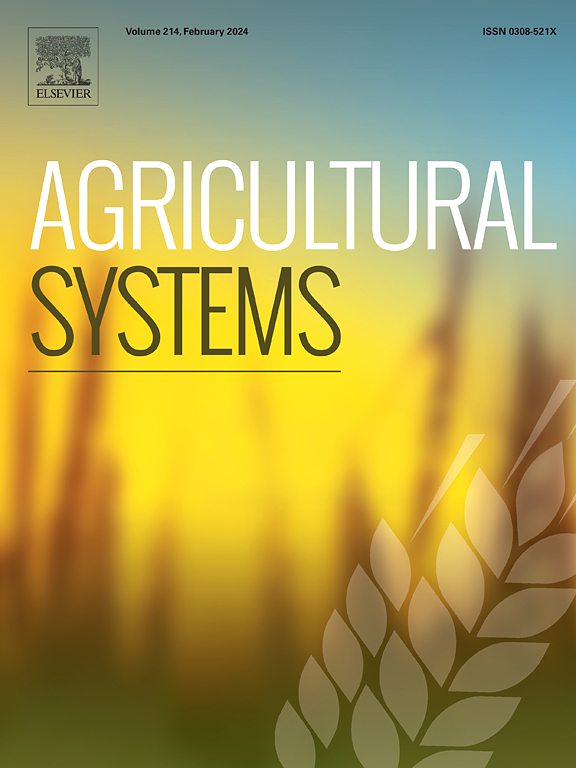Use of atypical plant resources for cattle farming in Western Europe to drive agroecological transition
IF 6.1
1区 农林科学
Q1 AGRICULTURE, MULTIDISCIPLINARY
引用次数: 0
Abstract
CONTEXT
In the efforts to optimize their production processes and yields, livestock systems overlook less productive on-farm areas and resources. Given the challenges of feed self-sufficiency, climate change mitigation and adaptation, and biodiversity conservation, it makes sense to revalue these resources to support agroecological transition in livestock systems.
OBJECTIVE
This paper introduces the concept of ‘atypical resources’, defined as plant resources that are part of the farm environment but are not conventionally used. The aim is to explore their nature, access, use and potential contribution to the performance of livestock systems.
METHODS
The study examines four unique and under-researched cattle farming systems (dairy or beef) using atypical resources in Western France through comprehensive analysis, and assessment of nitrogen metabolism.
RESULTS AND CONCLUSIONS
Our results show a rich diversity of atypical resources such as abandoned land, hedgerow slopes, woody leaves, ditch bottoms and marsh reeds. These resources, coming from the farms themselves or their surroundings, are used for animal feed and/or bedding. The contribution of atypical resources in the nitrogen metabolism of the system ranges from almost 0 % to 12 %, while their contribution to animal feed varies for almost 0 % to 29 %. In addition, the management practices and grassland-based farming systems associated with these resources may limit N waste, preserve habitats and enhance biodiversity.
SIGNIFICANCE
This article examines an under-explored but critical issue that is essential to address the current challenges of livestock systems in Western Europe. We advocate for further research to generate knowledge and methods that harness the multiple services provided by atypical resources, thereby facilitating agroecological transition and addressing spatial management challenges.

利用非典型植物资源在西欧养牛,推动农业生态转型
在优化生产过程和产量的过程中,畜牧业系统忽视了生产力较低的农场区域和资源。鉴于饲料自给自足、减缓和适应气候变化以及保护生物多样性等挑战,重估这些资源的价值以支持畜牧系统的农业生态转型是有意义的。本文介绍了“非典型资源”的概念,定义为作为农场环境的一部分但不被常规使用的植物资源。目的是探讨它们的性质、获取途径、利用及其对牲畜系统性能的潜在贡献。方法通过综合分析和氮代谢评估,研究了法国西部使用非典型资源的四种独特且研究不足的牛养殖系统(乳制品或牛肉)。结果与结论研究结果显示,该地区的非典型资源具有丰富的多样性,如废弃地、绿篱坡、木本叶、沟底和沼泽芦苇等。这些来自农场本身或其周围环境的资源用于动物饲料和/或床上用品。非典型资源对系统氮代谢的贡献几乎在0%到12%之间,而它们对动物饲料的贡献几乎在0%到29%之间。此外,与这些资源相关的管理实践和草地农业系统可能会限制氮的浪费,保护栖息地并增强生物多样性。本文探讨了一个未被充分探索但至关重要的问题,该问题对于解决西欧畜牧业系统当前面临的挑战至关重要。我们提倡进一步研究,以产生利用非典型资源提供的多种服务的知识和方法,从而促进农业生态转型并应对空间管理挑战。
本文章由计算机程序翻译,如有差异,请以英文原文为准。
求助全文
约1分钟内获得全文
求助全文
来源期刊

Agricultural Systems
农林科学-农业综合
CiteScore
13.30
自引率
7.60%
发文量
174
审稿时长
30 days
期刊介绍:
Agricultural Systems is an international journal that deals with interactions - among the components of agricultural systems, among hierarchical levels of agricultural systems, between agricultural and other land use systems, and between agricultural systems and their natural, social and economic environments.
The scope includes the development and application of systems analysis methodologies in the following areas:
Systems approaches in the sustainable intensification of agriculture; pathways for sustainable intensification; crop-livestock integration; farm-level resource allocation; quantification of benefits and trade-offs at farm to landscape levels; integrative, participatory and dynamic modelling approaches for qualitative and quantitative assessments of agricultural systems and decision making;
The interactions between agricultural and non-agricultural landscapes; the multiple services of agricultural systems; food security and the environment;
Global change and adaptation science; transformational adaptations as driven by changes in climate, policy, values and attitudes influencing the design of farming systems;
Development and application of farming systems design tools and methods for impact, scenario and case study analysis; managing the complexities of dynamic agricultural systems; innovation systems and multi stakeholder arrangements that support or promote change and (or) inform policy decisions.
 求助内容:
求助内容: 应助结果提醒方式:
应助结果提醒方式:


